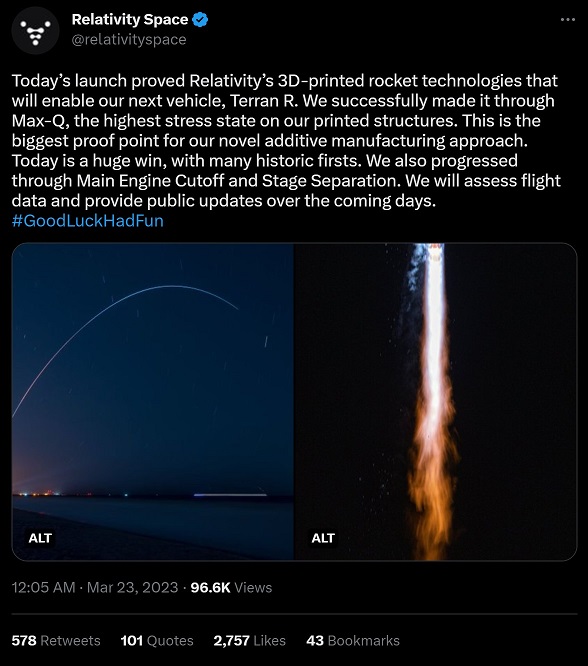Relativity’s 3D Printed Rocket Launch Second Stage Engine Malfunctions Causing it to Fail Reaching Orbit
Yesterday, history was made when Relativity Space launched its Terran 1 rocket, the world’s first 3D printed rocket, from Cape Canaveral Space Force Station in Florida. However, the historic flight ended in disappointment when the rocket failed to reach orbit after its second stage engine malfunctioned. Despite the failure this moment was a significant milestone for 3D printing technology, and what are the implications for the future of space exploration.
The Launch
The launch was scheduled for 8:25 p.m. EST on March 22, after two previous attempts were scrubbed due to technical issues. The rocket lifted off successfully from Launch Complex 16, a former missile site that Relativity Space leased from the U.S. Air Force.
The first stage of the rocket performed well, surviving Max-Q (the point of maximum aerodynamic pressure) and separating from the second stage as planned. The second stage ignited briefly but then shut down prematurely, causing it to fall back into the Atlantic Ocean along with its payload.
The payload was a metal 3D print that Relativity Space made six years ago as its first prototype. The company wanted to put it into a low Earth orbit for several days before having it reenter and burn up in the atmosphere, as a symbolic gesture of its journey from inception to flight.
The Significance
Despite the failure, Relativity Space achieved some important milestones with this launch. It was the first time that a rocket made almost entirely of 3D printed parts took flight, demonstrating that additive manufacturing can produce viable and complex aerospace products.
According to Relativity Space, 85% of Terran 1’s parts were made by its huge Stargate printers in Long Beach, California. These printers use robotic arms and lasers to deposit layers of metal powder and fuse them into solid structures.
By using 3D printing, Relativity Space claims that it can reduce the number of parts in a rocket from about 100,000 to less than 1,000, lower costs by up to 90%, shorten development time by months or years, and enable rapid iteration and customization.
The company also aims to make its rockets reusable for multiple flights by using advanced materials and software. Its ultimate vision is to use its technology to build rockets on Mars and enable human colonization of other worlds.

The Implications
Relativity Space is not alone in pursuing 3D printing technology for space applications. Other companies such as SpaceX, Blue Origin, Rocket Lab, Virgin Orbit and Firefly Aerospace also use additive manufacturing for some components of their rockets or engines.
However, Relativity Space stands out for its ambitious goal of making an entire rocket out of 3D printed parts. This could give it an edge over competitors in terms of cost efficiency and flexibility.
The company has already secured contracts with several customers including NASA, Telesat Canada and Iridium Communications for future launches using Terran 1 or its larger successor Terran R (which is also planned to be fully reusable).
The failure of Terran 1’s debut flight does not mean that Relativity Space’s vision is doomed. Rockets rarely succeed on their first attempt; even SpaceX’s Falcon 1 failed three times before reaching orbit on its fourth try.
Relativity Space said that it gathered enough data from this launch to show that flying 3D printed rockets is feasible and that it will learn from this experience and improve its design for future flights.
What do you think about Relativity Space’s attempt at launching a 3D printed rocket? Do you think this technology will revolutionize space exploration?
Explore Related Articles

The Best “Yardi Gras” Decorations Seen After New Orleans Natives Transformed...
With COVID-19 changing the world as we know people are finding many different ways to improvise in an effort to keep old traditions alive and well. This year creative minds created a new "Yardi Gras" tradition to replace Mardi Gras, which was cancelled for obvious reasons.
With the birth...
Who is the Second Oldest Woman in the World in 2023...
A favorite meal can be more than just a source of nourishment and pleasure. It can also be a way of celebrating life, culture, and memories. For some people, a favorite meal can even be a part of their longevity secret. But what happens when the person who enjoys...
Political Conspiracy Theory of Why Myanmar OnlyFans Model Nang Mwe San...
OnlyFans is a platform that has risen to new heights in recent years as an easy way for people to make money while showing off their bodies. We have all heard countless stories of how women who were working regular jobs turned to OnlyFans to become rich in a...






